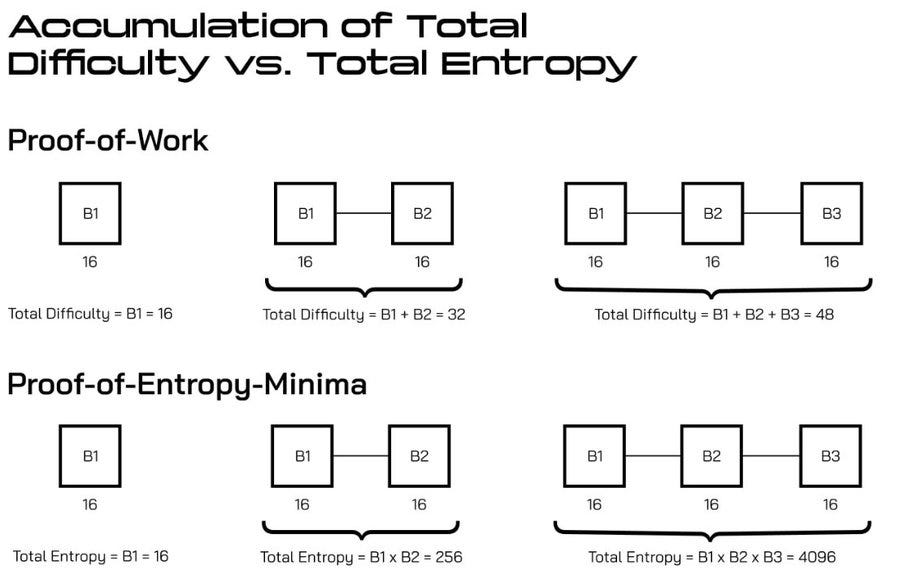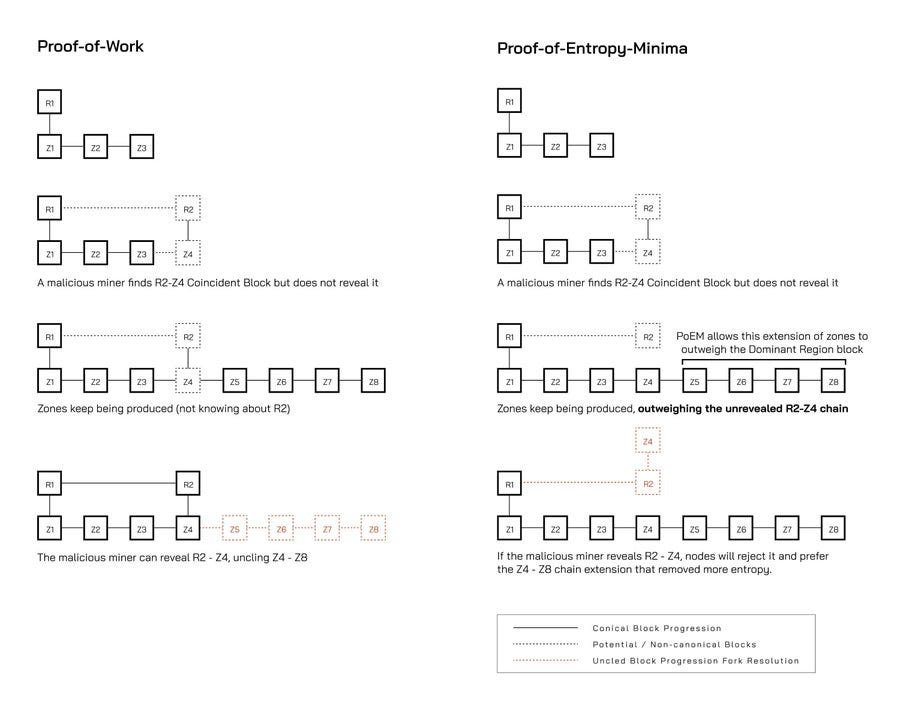🌟Quai Network’s PoEM - Better than PoW & PoS?
 CrypLykos
CrypLykos
Quai Network uses Proof-of-Entropy-Minima (PoEM), inspired by Bitcoin’s Proof-of-Work (PoW) Nakamoto Consensus. PoEM measures intrinsic block weight to calculate entropy, ensuring all nodes prefer one block.
It eliminates contention and allows continuous agreement, offering benefits like instantaneous fork resolution and faster finality.
💠Fork Choice: Every node in the system consistently makes the same decision on the block.
💠Finality: Faster Finality POEM offers a faster mathematical guarantee of on-chain inclusion than all existing consensus mechanisms.
💠Sharding: Perpetual consensus is crucial for coordinating infinite execution shards, as mechanisms that take time to resolve contention are ineffective for coordinating multiple chains.
💠Fork Choice
🔹Instantaneous Fork Resolution
👉How the PoEM consensus mechanism eliminated consensus-based forks.
Fork resolution in blockchain systems is a challenge due to the prolonged uncertainty it introduces. Proof-of-Work consensus requires nodes to disregard meaningful aspects of proposed hashes, making it unreliable for achieving consensus with multiple blockchains.
Proof-of-Entropy-Minima (PoEM) uses intrinsic block weight to enable deterministic block selection and eliminates consensus-based forks.
PoEM ensures consensus can always be reached by propagating a single proof, resulting in the most efficient utilization of computational resources.
PoEM mechanism achieves perpetual consensus by eliminating latency, ensuring all nodes agree on the “tip” of the blockchain, even without complete system information.

🔹Intrinsic Block Weight
👉How blocks are measured and compared in Quai Network.
PoEM measures the entropy removed from a system when each block is formed, ensuring quick and unanimous decision-making between blocks.
This method differs from conventional Proof-of-Work systems, which consider varying entropy levels. Comparing entropy allows for objective blockchain decision-making.
🔹Calculating Total Entropy
👉How total entropy accumulates in Quai Network.
Proof-of-Entropy-Minima (PoEM) is a blockchain-based method that measures entropy reduction, providing a more accurate measure of energy usage.
It differs from Proof-of-Work (PoW) in that it calculates total entropy geometrically, while PoW calculates it linea
💠Finality
🔹Faster Finality
👉How transactions achieve faster finality in Quai Network.
Proof-of-Entropy-Minima (PoEM) offers quicker statistical finality in hash-based blockchains by measuring entropy, a concept rooted in physics, rather than “work,” allowing nodes to identify blocks requiring the most energy.
Statistical Finality
Quai Network uses dominant and subordinate blockchains, reducing withholding attacks on dominant chains.
PoEM measures entropy removal faster than dominant chains, allowing subordinate chains to achieve statistical finality independently of dominant block inclusion.
This bottom-up approach reduces the maximum time of a dominant withholding attack, ensuring data canonicality in a fork.
Finality, a mathematical certainty that data is immutable unless there’s a 51% attack, differs from economic finality. Under PoEM, subordinate zone blockchains’ statistical finality doesn’t depend on dominant block production or inclusion.
💠Sharding
🔹Execution Sharding
👉How Quai Network organizes many chains into one network.
Proof-of-Work (PoW) systems struggle with time delays, limiting the speed of coordinating multiple work-based blockchains or execution threads.
Proof-of-Entropy-Minima (PoEM) offers a solution with deterministic fork resolution, allowing nodes to quickly select the correct chain tip across execution shards.
This improves scalability of distributed ledger technology, allowing networks like Quai to support high throughput and low latency applications.
Quai Network uses a dynamic sharding algorithm to add execution shards decentralized, reducing time to global settlement, unlike existing blockchain networks that compromise security.
🔹Dynamic Sharding
👉The process of dynamically scaling to more shards in Quai Network.
Quai Network utilizes Proof-of-Entropy-Minima (PoEM) to efficiently coordinate execution shards, enabling dynamic capacity increase to meet demand.
Dynamic sharding creates new region chains and zones, connecting them to the network’s consensus, and adding an additional subordinate zone.
The Quai protocol utilizes two network properties to determine when to add execution shards: the rate of uncle blocks and the gas limit.
Uncle Rate
Uncle blocks in blockchain protocols reduce hash efficiency and slow finality. Quai protocol measures uncle block rate, creating blocks for additional regions and zone chains to increase throughput and maintain high hash-efficiency.
Gas Limit
The Quai protocol monitors block capacity by analyzing gas usage. When gas limits are reached, fees increase. Quai Network maintains transaction fees under $0.01 by adding execution shards.
More information about Quai Network
💎Quai Network Introduction — A Hidden Gem
🖥️Quai Network Upcoming Golden Age Testnet — Developer
✨Total funding raises to $15M💰💰
Website | Discord | Github | Twitter | Youtube | Reddit | LinkedIn | Docs
Subscribe to my newsletter
Read articles from CrypLykos directly inside your inbox. Subscribe to the newsletter, and don't miss out.
Written by

CrypLykos
CrypLykos
🫡 I want to start a journey to learn & improve myself. I would like to share my research in Web3 & my technical Analysis on DXY, ES, XAU & Crypto (purely on chart without any indicator). Check out my Twitter @cryplykos I hope everyone finds it useful. Any feedback is appreciated so I can be better. Thank you & enjoy. 🙏



